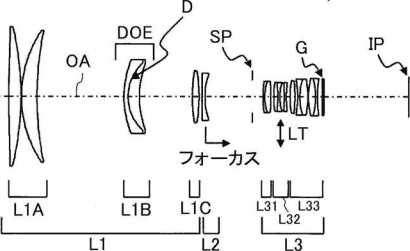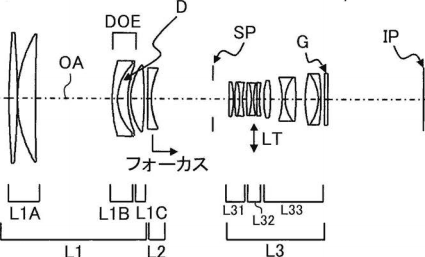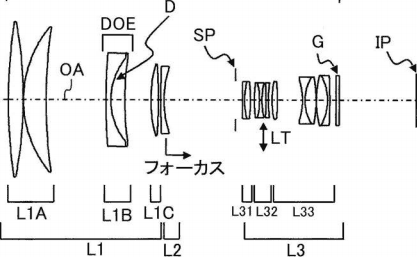Join More Than 50,000+ Subscribers and get latest camera news and rumors
NEW CAMERA VIDEOS ON YOUTUBE
|
By admin, on May 24th, 2013
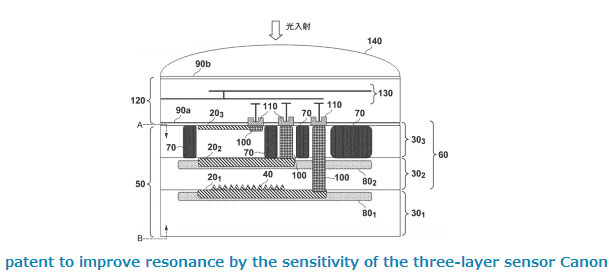
Canon new Three-Layer sensor patent surfaced over the web, the three layer sensor will increase the sensitivity & Overall performance of the camera take a look at the details below,
Description and self-interpretation of the patent literature / Translated by google
- Patent Publication No. 2013-93553
- Publication date 2013.5.16
- Filing date 2011.10.4
- Imaging element of three-layer structure
- Photodiode deep layer (hereinafter, PD) in the charge is diffused into the substrate
- Thus sensitivity is poor red
- Canon patent of
- I as a photonic crystal of irregular shape, the boundary surface of the PD of red or green,
- In the periodic structure of uneven spacing, less than twice the 1/4 times or more the wavelength of light, or I shall be two times or less 1/2 times or more
- Irregular shape has the properties to be spatially-localized or resonant light
- The incident light is diffracted, it combines with the light of the boundary plane, the resonant
- Prolonged exists than normal, the light becomes easy to be absorbed by the PD Thus
Also See – Canon Sensor Image Quality Trapped in Time | See more Canon Patents
src- egami.blog.so-net.ne.jp/2013-05-22
By admin, on May 17th, 2013
More patent news coming from Canon side, A bunch of new DO (Diffractive Optics) patent surfaced over the web – 500mm f/4, 500mm f/5.6, 600mm f/4, 800mm f/5.6, more details translated by google below
Description and self-interpretation of the patent literature
- Patent Publication No. 2013-92575
- Publication date 2013.5.16
- Filing date 2011.10.24
- Example
embodiment
| No. |
Focal length [mm] |
Fno. |
Half angle [°] |
Total length [mm] |
BF [mm] |
Front lens diameter [mm] |
| One |
584.99 |
4.12 |
2.12 |
420.00 |
89.03 |
141.99 |
| Two |
779.99 |
5.80 |
1.59 |
460.00 |
97.84 |
134.48 |
| Three |
488.99 |
4.11 |
2.53 |
320.00 |
61.00 |
119.00 |
| Four |
488.99 |
5.70 |
2.53 |
280.01 |
65.01 |
85.79 |
| Five |
584.96 |
4.12 |
2.12 |
420.00 |
88.88 |
141.98 |
Image height 21.64mm
- How to reduce the size of the large-aperture super telephoto lens
- Effective diameter of the first group with the largest
- I reduce the number of the first group
- It is necessary to reduce aberration by increasing the number
- Can not reduce the aberration and reduce the number
- I increase a refractive power of the first group
- The thickness of the lens increases, the effect of weight reduction is canceled
- Impact of manufacturing error is large high refractive index
- Canon patent
- The aspherical in the first group
- Performing a variance of sensitivity was composed of opposite sign component of the first group, and also, prevent an increase in thickness
- DOE is provided to correct chromatic aberration with a small number of lenses
- Inner focus
- Anti-shake
About DO Lenses
Diffraction is an optical phenomenon in which light waves bend as they pass around the edges of an object. In the late 1990s, a team of young Canon engineers came up with the idea of using this phenomenon to counteract chromatic aberration.
A single diffractive optical (DO) element features diffractive gratings – very fine parallel grooves on the surface – which change the direction of light. However, this process generates diffracted light that is not suitable for photographic lenses and can cause flaring.
Employing multiple DO elements ensures that nearly all light allowed to pass through the DO elements can be used for photography. Canon DO lenses use multiple DO elements whose diffractive gratings are bonded face-to-face. Combining this arrangement with a refractive convex lens almost completely cancels out chromatic aberration while allowing the lens elements to be placed much closer together within the lens barrel. The result is a high performance EF lens that’s significantly shorter and lighter than typical refractive lenses. In fact, the EF 400mm f/4 DO IS USM is 27% smaller and 31% lighter than a conventional 400mm f/4 lens would be.
Fast becoming a favourite with sports and news photographers, DO lenses are making high performance telephoto shooting easier and more manageable than ever before.
By admin, on May 16th, 2013
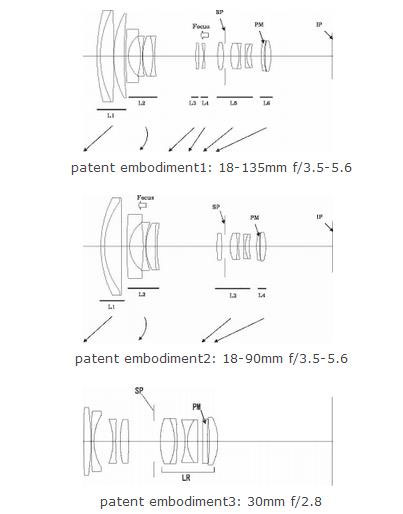
Canon 3 new lens patent surfaced over the web today, Canon 30mm f/2.8, 18-90mm f/3.5-5.6, 18-135mm f/3.5-5.6 Lenses, take a look at the details below, translated by google
Description and self-interpretation of the patent literature
- Patent Publication No. 2013-88736
- Publication date 2013.5.13
- Filing date 2011.10.21
- Example 1
- Zoom ratio 7.02
- Focal length f = 18.60 – 130.50mm
- Fno 3.59 -. 5.88
- Half angle ω = 36.29 – 5.98 °
- Image height 13.66mm
- 187.48mm – 138.01 overall length of the lens
- BF 35.60 – 70.79mm
- Effective diameter of 58.92mm front lens
- 16 pieces of 12-group lens configuration
- One piece of one aspherical surface
- One UD glass
- 6-group zoom positive and negative negative positive positive
- Inner Focus (Group 4)
- Example 2
- Zoom ratio 4.73
- Focal length f = 18.60 – 87.97mm
- Fno 3.59 -. 5.88
- Half angle ω = 36.29 – 8.83 °
- Image height 13.66mm
- 164.98mm – 125.04 overall length of the lens
- BF 35.60 – 69.29mm
- Effective diameter of 61.54mm front lens
- 13 pieces of 9 lens configuration
- One piece of one aspherical surface
- 4-group zoom positive and negative positive positive
- Inner Focus (the second group)
- Example 3
- Focal length f = 29.48mm
- Fno. 2.92
- Half angle ω = 24.86 °
- Image height 13.66mm
- The overall length of the lens 78.43mm
- BF 35.40mm
- Effective diameter of 22.43mm front lens
- 10 pieces of 8 lens configuration
- One piece of one aspherical surface
- Resin lens
- Vulnerable to temperature change
- There are restrictions on the type of coating, ghost and flare cause of
- Canon patent
- The final lens group is arranged a resin lens having a concave surface facing the image side, and place the glass lens on the image side
- Weaken the power of the resin lens, I reduce the performance variation due to temperature change
- Incident light axial rays is arranged in a low position of the resin lens, to suppress the influence of the birefringence variation of the resin lens
- Likely to occur in the concave surface of the resin lensghost is avoided by optimization of the power of the air lens in the shape of the glass lens and resin lens, in the meantime
By admin, on December 17th, 2012
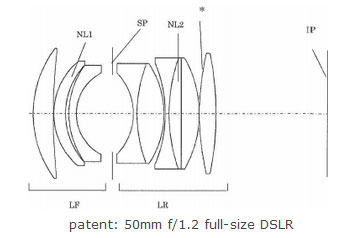 According to the latest patent surfaced over the web, the 50mm F1.2 Lens is coming for a full-frame mirrorless camera, just few dyes ago we have seen lens patent made for Canon 4/3 mirrorless camera, Sure we will see a whole new range of mirrorless camera from Canon in 2013. According to the latest patent surfaced over the web, the 50mm F1.2 Lens is coming for a full-frame mirrorless camera, just few dyes ago we have seen lens patent made for Canon 4/3 mirrorless camera, Sure we will see a whole new range of mirrorless camera from Canon in 2013.
Self-interpretation and summary, Patent Documents
- Patent Publication No. 2012-247451
- Release Date 2012.12.13
- Filing date 2011.5.25
- Example 1
- Focal length f = 51.70mm
- Fno. 1.25
- Half angle of view ω = 22.71 °
- Image height 21.64mm
- 105.65mm length lens
- BF 40.00mm
- Nine 6 groups lens configuration
- One one aspherical surface
- Maximum effective diameter 45.16mm
- Example 4
- Focal length f = 50.00mm
- Fno. 2.06
- Half angle of 23.40mm
- Image height 21.64mm
- Length 72.62mm lens
- BF 28.86mm
- Eight four group lens configuration
- No aspherical
- Maximum effective diameter 33.34mm
- General symmetric lens
- Compensation of magnification chromatic aberration can be
- Difficult to correct axial chromatic aberration and the large-diameter
- Canon patent
- Symmetric lens large aperture
- Positive, aperture, arranged in the order of the positive
- Using a high anomalous dispersion glass, the axial chromatic aberration is corrected
src – egami
By admin, on December 16th, 2012
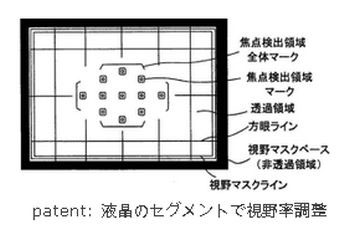 Canon patent a small optical viewfinder with 100% coverage, so we may see some modified versions of small DSLRs or G series camera with bright optical viewfinders. Canon patent a small optical viewfinder with 100% coverage, so we may see some modified versions of small DSLRs or G series camera with bright optical viewfinders.
Self-interpretation and summary, Patent Documents
- Patent Publication No. 2012-237877
- 2012.12.6 Release Date
- Filing date 2011.5.12
- 100% field of view finder is greater reason
- Space is required movement of the mask field of view finder optical system and
- Canon patent
- PN liquid crystal panel disposed on the outer periphery of the display element within the viewfinder
- By the application of a voltage to switch the transmission and non-transmission of the display segments
- For adjustable without the need for physical movement space, downsizing can be electronically
src- egami
By admin, on November 20th, 2012
Canon will soon announce a Micro Four Thirds Mirrorless Camera?, Two new patents of 12-28mm F2-3.2 and 14-28mm F1.4-2.4 lens designed for 4/3 ” Sensor revealed by japanese patent hunting blog egami, We already have bundle of rumor that Canon is ready to announce a new compact system camera in Jan/Feb of 2013.
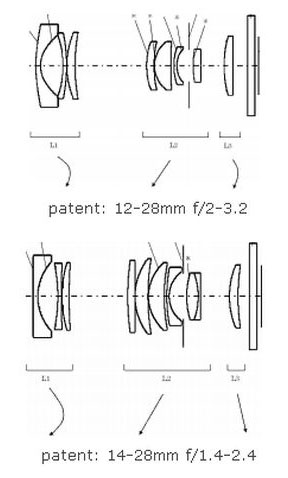
But at the end the intention of Canon is not clear, whether they are adding a new EOS M body to existing line of mirrorless camera or Canon will soon announce a new advanced compact camera with big 4/3 format sensor. Stay with us on twitter and Facebook we will update you as we get any new info.
source
By admin, on July 30th, 2012
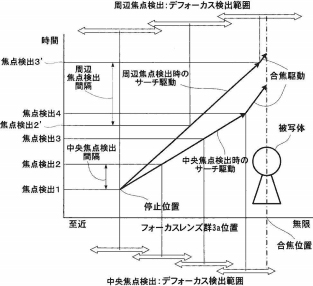 New patent news coming from patent hunter Japanese blog egami, the latest technology aims at improving speed and accuracy of the current AF system used by Canon, So we may see some more advance AF system based PRO and Entry level DSLR camera in near future. New patent news coming from patent hunter Japanese blog egami, the latest technology aims at improving speed and accuracy of the current AF system used by Canon, So we may see some more advance AF system based PRO and Entry level DSLR camera in near future.
Patent details translated by google
- Patent Publication No. 2010-60771
- 2010.3.18 Release Date
- 2008.9.3 filing date
- Existing techniques
- Patent Publication No. H11-281878
- Different lengths of baseline using the AF sensor
- F2.8 sensor: high focusing accuracy
- Can detect a wide range of defocus amount (the amount of deviation of focus): F5.6 sensor
- After roughly at F5.6 sensor is focused, making focus F2.8 sensor with high accuracy
- Drawback
- Depending on the timing F2.8 sensor is not used, focusing accuracy is not good
- Canon’s patent
- Different lengths of baseline using the AF sensor
- Because of the defocus amount detection range is limited, must search as duplicate detection range
- By using the F5.6 sensor, within a limit not exceeding the amount of defocus, it is possible to focus lens is driven at high speed
- If the Live View
- The image plane using phase difference AF
- Focus lens is driven at high speed
- Using the central pixel: When low-intensity
- Using the neighboring pixels: When high-intensity
for a quick reminder Canon recently announced 650D and Canon EOS M with hybrid AF system
News src –Egami | See more Canon Patents
|
KEEP THIS BLOG ALIVE - Support New Camera Buy Canon Lenses, Buy Music CD or Digital Camera at amazon it helps this site, and you do not pay anything extra, it is just a way to help support this site.

|



